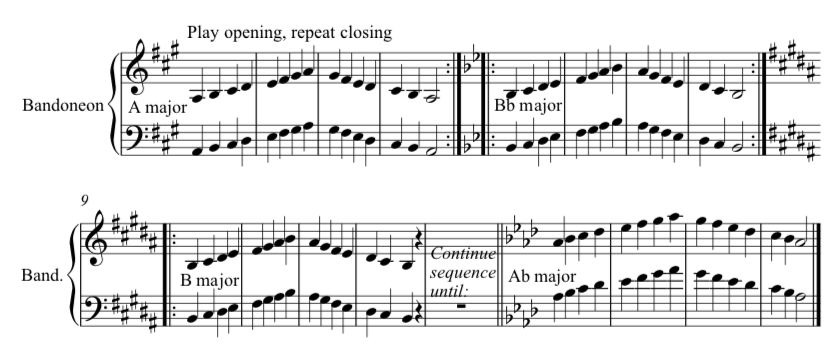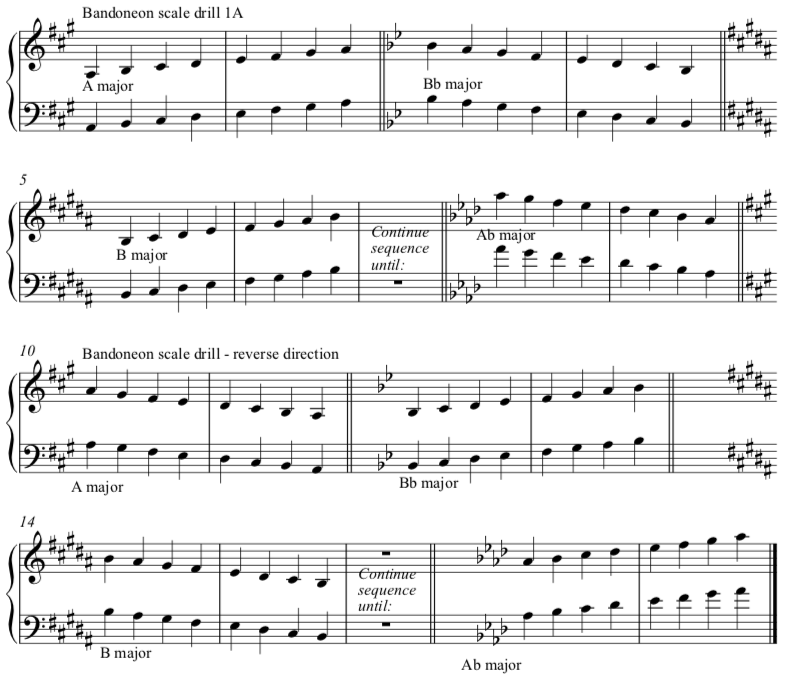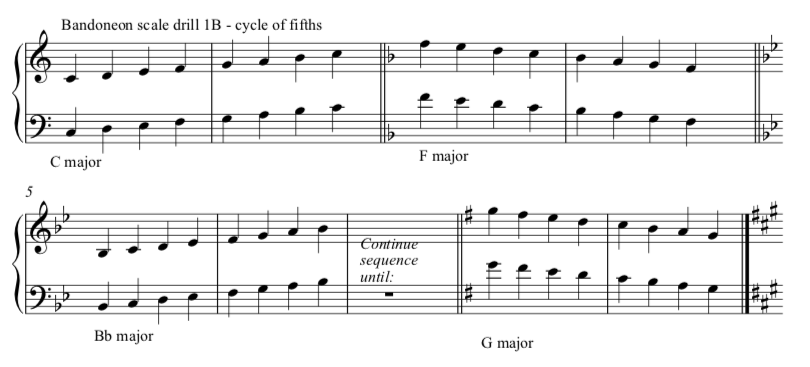Scales and arpeggios are an invaluable tool for improving technique and internalising the patterns of melodies and chords which all tonal music is built from.
On the bandoneon, we should respect the facts that some areas of the instrument’s range are not suited to melodic work, and that each octave of each scale is a different pattern. My recommendation is to play scales of one octave both hands together, focusing on the top of the Left hand range and the bottom and middle of the Right Hand range. In this article I suggest a practise to build up one’s competence in the major scales and arpeggios, and then a daily practise method to deepen one’s skills once the basic mechanics have been worked out. But first, some tips:
Tip 1: do these exercises without looking at music. This develops the internal musical map which is particularly essential on the bandoneon, an instrument whose layout bears no relationship to the musical space, unlike for instance the piano.
Tip 2: treat these exercises as an opportunity to do ones daily bellows practise as well. Be mindful of good bellows control. This will become easier as the note patterns become more internalised and subconscious.
Tip 3: Always seek to improve the freedom of the hands to move about the instrument, effortless management of the bellows, and relaxation of the entire body, in particular the arms, legs, lower back and pelvic region.
Tip 4: I show major scales here, but the exercises can also be repeated with minor (natural, melodic, harmonic), and any other modes you care to learn (mixolydian, dorian and so on). Major is the paradigmal mode and the obvious starting place; melodic and harmonic minors are the next most useful ones for tango music. The other modes are relevant if one is developing jazz techniques. It’s all a matter of time!
Preparatory scale exercise
This exercise is to learn play one octave scales both hands together, starting with the right Hand at the bottom of the range on A and the left hand an octace lower. The scales then ascend chromatically:

Description: One octave major scales ascending and descending, all twelve keys starting on A and ascending by semitones Bb B C etc. Each scale to be played opening and then closing.
Start by learning the hands separately and then proceed to hands together
Tip 5: you don’t have to learn the scales in the order shown. If you are also stuying a piece in say D major, learn the scales relevant to that piece, e.g. D, G, A and any scales the piece modulates to. Eventually learning all 12 keys will be invaluable but one should focus on what is possible in the available practise time.
The Major Scale Drill
This is a practise drill in all 12 keys that I normally start my daily practise with.

Description: as in the first exercise, the major scales in all keys built on each semitone starting on A, playing the first scale ascending, the second descending, the third ascending and so on; the order to then be reversed.
Bellows: you can start working on this playing two bars per bellows (i.e. one scale in one direction on each bellows) – two bars opening, two bars closing etc. IMPORTANT: always repeat the exercise starting on the opposite bellows direction so that all the scales are practised in both bellows directions.
Once facility is achieved, breath as follows – four keys per bellows:
Opening A Bb B C Closing Db D Eb E Opening F F# G Ab – then reverse the bellows direction. Do this on the reverse scale direction exercise too.
Variation: Cycle of Fifths
The great thing about this version of the scale drill is that the sequence of scales is what one typically finds in actual music – progressing through chords separated by a 5th. Therefore, as well as reinforcing the scales, one is also gaining facility in the context switch between related keys.
The order of keys here is: C F Bb Eb Ab Db F# (Gb) B E A D G

As with the first scale drill, play this upside down as well, i.e. starting with the descending scale, and play the whole thing again with the reverse belows order. When up to speed one can play 4 keys per bellows as with the original exercise.
Arpeggios
All tonal music is made up of scalic movements and chord tone movements ( as well as neighbour notes and chromatic notes, but never mind those for now!) Practise arpeggios to internalise melodic leaps within a key as well as chord fingering patterns.

Description: Major arpeggios on each key starting on A and ascending in semitones, the first played ascending, the second descending, and so on. Then reverse the order i.e. descending then ascending.
You can prepare for this exercise, as with the scales, by practising ascending and descending in each key. Play this exercise in the opposite direction as well, i.e. start with a descending arpeggio. And always remember to practise the reverse belows order. You can play four keys per bellows movement, and then see if you can play all 12 keys in one bellows, opening and then closing. It’s a great exercise for air management. It is also most helpful to play this Arpeggio exercise around the cycle of 5ths : C F Bb Eb Ab Db Gb/F# B E A D G.
Should I play Gb major or F# major? My advice is to play both; although the notes/buttons are exactly the same, the mental contorsions are completely different. One has to be prepared for anything!